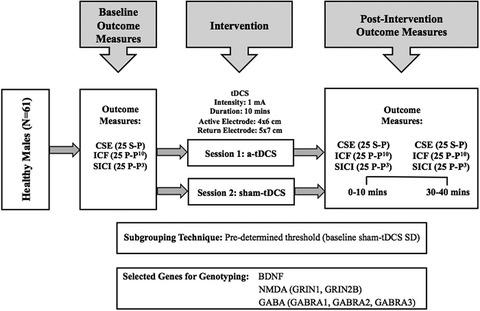当前位置:
X-MOL 学术
›
Eur. J. Neurosci.
›
论文详情
Our official English website, www.x-mol.net, welcomes your
feedback! (Note: you will need to create a separate account there.)
Can genetic polymorphisms predict response variability to anodal transcranial direct current stimulation of the primary motor cortex?
European Journal of Neuroscience ( IF 2.7 ) Pub Date : 2020-10-13 , DOI: 10.1111/ejn.15002 Michael Pellegrini 1 , Maryam Zoghi 2 , Shapour Jaberzadeh 1
European Journal of Neuroscience ( IF 2.7 ) Pub Date : 2020-10-13 , DOI: 10.1111/ejn.15002 Michael Pellegrini 1 , Maryam Zoghi 2 , Shapour Jaberzadeh 1
Affiliation

|
Genetic mediation of cortical plasticity and the role genetic variants play in previously observed response variability to transcranial direct current stimulation (tDCS) have become important issues in the tDCS literature in recent years. This study investigated whether inter‐individual variability to tDCS was in‐part genetically mediated. In 61 healthy males, anodal‐tDCS (a‐tDCS) and sham‐tDCS were administered to the primary motor cortex at 1 mA for 10‐min via 6 × 4 cm active and 7 × 5 cm return electrodes. Twenty‐five single‐pulse transcranial magnetic stimulation (TMS) motor evoked potentials (MEP) were recorded to represent corticospinal excitability (CSE). Twenty‐five paired‐pulse MEPs were recorded with 3 ms inter‐stimulus interval (ISI) to assess intracortical inhibition (ICI) via short‐interval intracranial inhibition (SICI) and 10 ms ISI for intracortical facilitation (ICF). Saliva samples were tested for specific genetic polymorphisms in genes encoding for excitatory and inhibitory neuroreceptors. Individuals were sub‐grouped based on a pre‐determined threshold and via statistical cluster analysis. Two distinct subgroups were identified, increases in CSE following a‐tDCS (i.e. Responders) and no increase or even reductions in CSE (i.e. Non‐responders). No changes in ICI or ICF were reported. No relationships were reported between genetic polymorphisms in excitatory receptor genes and a‐tDCS responders. An association was reported between a‐tDCS responders and GABRA3 gene polymorphisms encoding for GABA‐A receptors suggesting potential relationships between GABA‐A receptor variations and capacity to undergo tDCS‐induced cortical plasticity. In the largest tDCS study of its kind, this study presents an important step forward in determining the contribution genetic factors play in previously observed inter‐individual variability to tDCS.
中文翻译:

遗传多态性能否预测初级运动皮层阳极经颅直流电刺激的反应变异性?
皮质可塑性的遗传介导和遗传变异在先前观察到的对经颅直流电刺激 (tDCS) 的反应变异性中所起的作用已成为近年来 tDCS 文献中的重要问题。本研究调查了 tDCS 的个体间变异性是否部分由遗传介导。在 61 名健康男性中,通过 6 × 4 cm 的主动电极和 7 × 5 cm 的返回电极以 1 mA 的电流将阳极-tDCS (a-tDCS) 和假-tDCS 施用于初级运动皮层 10 分钟。记录了 25 个单脉冲经颅磁刺激 (TMS) 运动诱发电位 (MEP) 以代表皮质脊髓兴奋性 (CSE)。以 3 ms 的刺激间期 (ISI) 记录 25 个双脉冲 MEP,以通过短间隔颅内抑制 (SICI) 评估皮质内抑制 (ICI),并以 10 ms ISI 评估皮质内促进 (ICF)。测试唾液样本中编码兴奋性和抑制性神经受体的基因中的特定遗传多态性。根据预先确定的阈值并通过统计聚类分析对个体进行分组。确定了两个不同的亚组,a-tDCS 后 CSE 增加(即响应者)和 CSE 没有增加甚至减少(即无响应者)。没有报告 ICI 或 ICF 的变化。没有报道兴奋性受体基因的遗传多态性与 a-tDCS 反应者之间的关系。据报道,a-tDCS 反应者与编码 GABA-A 受体的 GABRA3 基因多态性之间存在关联,表明 GABA-A 受体变异与经历 tDCS 诱导的皮质可塑性之间的潜在关系。在同类最大的 tDCS 研究中,这项研究在确定遗传因素在先前观察到的个体间变异对 tDCS 的贡献方面向前迈出了重要一步。
更新日期:2020-10-13
中文翻译:

遗传多态性能否预测初级运动皮层阳极经颅直流电刺激的反应变异性?
皮质可塑性的遗传介导和遗传变异在先前观察到的对经颅直流电刺激 (tDCS) 的反应变异性中所起的作用已成为近年来 tDCS 文献中的重要问题。本研究调查了 tDCS 的个体间变异性是否部分由遗传介导。在 61 名健康男性中,通过 6 × 4 cm 的主动电极和 7 × 5 cm 的返回电极以 1 mA 的电流将阳极-tDCS (a-tDCS) 和假-tDCS 施用于初级运动皮层 10 分钟。记录了 25 个单脉冲经颅磁刺激 (TMS) 运动诱发电位 (MEP) 以代表皮质脊髓兴奋性 (CSE)。以 3 ms 的刺激间期 (ISI) 记录 25 个双脉冲 MEP,以通过短间隔颅内抑制 (SICI) 评估皮质内抑制 (ICI),并以 10 ms ISI 评估皮质内促进 (ICF)。测试唾液样本中编码兴奋性和抑制性神经受体的基因中的特定遗传多态性。根据预先确定的阈值并通过统计聚类分析对个体进行分组。确定了两个不同的亚组,a-tDCS 后 CSE 增加(即响应者)和 CSE 没有增加甚至减少(即无响应者)。没有报告 ICI 或 ICF 的变化。没有报道兴奋性受体基因的遗传多态性与 a-tDCS 反应者之间的关系。据报道,a-tDCS 反应者与编码 GABA-A 受体的 GABRA3 基因多态性之间存在关联,表明 GABA-A 受体变异与经历 tDCS 诱导的皮质可塑性之间的潜在关系。在同类最大的 tDCS 研究中,这项研究在确定遗传因素在先前观察到的个体间变异对 tDCS 的贡献方面向前迈出了重要一步。











































 京公网安备 11010802027423号
京公网安备 11010802027423号